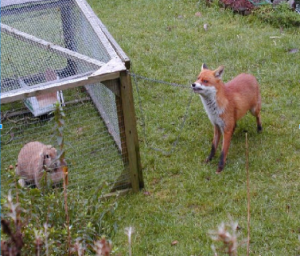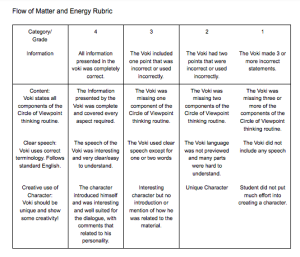Unit Objective
Examine how different organisms function and survive within their environment by writing from a different perspective.
Background and Rationale
Circle of Viewpoints was chosen to encourage students to consider multiple perspectives for life in the wild. This thinking routine connects to the lesson objectives as students examine how different organisms function and survive within their environment. As students explore a different perspective, the goal is that they gain a more complete understanding of the flow of matter and energy in nature.
Lesson Objectives
Objective |
Bloom’s Verb |
|---|---|
|
Define the energy relationships between plants and animals through a presentation of the final product. |
Remembering |
|
Identify how a variety of organisms meet their energy needs through a presentation of the final product. |
Understanding |
|
Generate a list of different perspectives or viewpoints, and remind the students their ideas can be nonliving items. |
Brainstorming |
|
Examine the flow of energy in nature. |
Analyzing |
| Create a Voki to share their viewpoints. | Creating |
|
Evaluate ideas of other students. |
Evaluating |
Bloom’s Taxonomy
Creating (highest level)
Common Core / State and District Standards
Science
-
GLE 0407.3.2 Investigate different ways that organisms meet their energy needs.
CCSS Writing
-
CCSS.ELA-LITERACY.W.4.9 Draw evidence from literary or informational texts to support analysis, reflection, and research.
Learning and Innovation Skills (P21.org)
Creativity and innovation
Think Creatively:
-
Use a wide range of idea creation techniques (such as brainstorming)
-
Create new and worthwhile ideas (both incremental and radical concepts)
-
Elaborate, refine, analyze and evaluate their own ideas in order to improve and maximize creative efforts
Life and Career Skills (P21.org)
Flexibility and Adaptability: Be Flexible
-
Incorporate feedback effectively
-
Deal positively with praise, setbacks and criticism
Initiative and Self Direction: Work Independently
-
Monitor, define, prioritize and complete tasks without direct oversight
Information, Media, and Technology Skills (P21.org)
Apply Technology Effectively
-
Use technology as a tool to research, organize, evaluate and communicate information
-
Use digital technologies (computers, PDAs, media players, GPS, etc.), communication/networking tools and social networks appropriately to access, manage, integrate, evaluate and create information to successfully function in a knowledge economy
Materials
-
Science Journal
-
Computer
Lesson – Introduction
Introduce the image by displaying it for the whole class to see. Ask the students what they notice and then ask them what they notice in relationship to our unit of study, “Flow of Matter and Energy” (food webs, basic needs, prey, predators, etc.). Generate a list of different perspectives or viewpoints, and remind the students it can be nonliving items. Students must then choose one viewpoint to examine, specifically relating to the flow of energy in nature. Students then complete the Circle of Viewpoints thinking routine (Ritchhart, Church, & Morrison, 2011, p. 171).
Lesson Activities and Procedures
-
Facilitate class discussion on the view points from the picture including living and nonliving things. From the discussion, make a class list for students to reference.
-
Students pick one of the viewpoints and examine it, specifically how it relates to the flow of energy in nature. Students will use this viewpoint to complete the Circle of Viewpoints thinking process.
-
Students will Think, Pair, Share their Circle of Viewpoints thinking process with another student who used the same or similar viewpoint.
-
Students will create a Voki character and include a voice that conveys all of the components of their Circle of Viewpoint thinking routine.
Lesson Closure
Students will present their Voki character portraying their Circle of Viewpoints to the whole class.
Assessment

Students will complete the Circle of Viewpoints thinking routine in their science journal, and then create their own Voki. Students will create their own Voki character and include a voice that conveys all of the components of their Circle of Viewpoint thinking routine. Students will then share, whole group, their end product.
References: Ritchhart, R., Church, M., & Morrison, K. (2011). Making Thinking Visible: How to Promote Engagement, Understanding, and Independence for All Learners. San Francisco, CA: Jossey-Bass Publishers.



